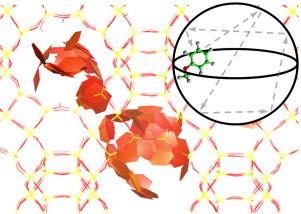孔结构对商用沸石催化剂中苯甲醚和愈创木酚的局部和纳米级迁移率的影响
IF 4.8
3区 材料科学
Q1 CHEMISTRY, APPLIED
引用次数: 0
摘要
利用准弹性中子散射(QENS)和分子动力学(MD)模拟研究了常见木质素衍生物苯甲醚和愈创木酚在商用酸性沸石催化剂中的动力学行为,以了解更简单的木质素衍生化合物在潜在工业催化剂中的扩散机制,从而将其转化为高附加值燃料和化学品。探查时间尺度为 ∼340 ps 的 QENS 实验观察并量化了工业酸性 H-Y 和 H-Beta 样品(硅/铝分别为 15 和 12.5)框架内的局部跃迁扩散,以及不同体系间速率不同的甲基旋转。随着沸石孔径从 H-Beta 到 H-Y 的增加,以及分子大小从愈创木酚到苯甲醚的减小,在整个温度范围内观察到扩散分子的比例增加了 2-3 倍。在两种框架中,较小的苯甲醚分子的扩散速度更快,跃迁距离更长,封闭扩散区域也更大。在实验时间尺度上通过 MD 模拟生成的 QENS 观察结果再现了这种封闭扩散,以及分子尺寸和框架拓扑结构对迁移率的影响。用 MD 探测扩展的纳秒时间尺度时,在两种沸石中,苯甲醚的扩散速度仍然比愈创木酚快,而且根据局部运动,愈创木酚在 H-Y 中的扩散速度比在 H-Beta 中快。然而,与实验观察/模拟的局部运动不同的是,苯甲醚在 H-Beta 中的纳米级扩散速度比在 H-Y 中快,这是因为 H-Beta 的直通道有利于纳米级的连续扩散,而在 H-Y 中,由于超级笼之间的跃迁障碍,超出限制区域的扩散速度较慢。除了分子尺寸较大外,愈创木酚的羟基与沸石布氏酸位点的相互作用比这两种分子所具有的甲氧基更强,从而进一步阻碍了扩散。这项研究强调了分子形状、功能性、立体孔隙阻碍和酸性位点相互作用之间的复杂相互作用,这些相互作用影响了木质素重要衍生物在潜在催化剂中的局部和纳米级流动性,从而将其转化为燃料和有用的化学品。本文章由计算机程序翻译,如有差异,请以英文原文为准。

The effect of pore structure on the local and nanoscale mobility of anisole and guaiacol in commercial zeolite catalysts
The dynamical behaviour of common lignin derivatives anisole and guaiacol within commercial acidic zeolite catalysts was investigated using quasielastic neutron scattering (QENS) and molecular dynamics (MD) simulations, to understand the diffusion mechanisms of simpler lignin-derived compounds in potential industrial catalysts for their conversion into value-added fuels and chemicals. QENS experiments probing timescales of 340 ps observed and quantified localised jump diffusion within the frameworks of industrial acidic H-Y and H-Beta samples (Si/Al = 15 and 12.5 respectively), and methyl rotations which differed in rate between systems. As the zeolite pore diameter increased from H-Beta to H-Y, and as molecular size decreased from guaiacol to anisole, an increase in the proportion of diffusing molecules was observed by a factor of 2–3 across the temperature range. Faster rates of diffusion, longer jump distances, and expanded regions of confined diffusion were observed for the smaller anisole molecule in both frameworks and for both molecules in H-Y over H-Beta, indicating that the ratio between catalyst pore diameter and molecular size significantly affects local diffusivity in these catalysts. QENS observables generated from the MD simulations over the experimental timescale reproduced this confined diffusion, along with the trends in mobility with molecular size and framework topology. Upon probing an extended nanosecond timescale with the MD, anisole still diffused more quickly than guaiacol in both zeolites, and guaiacol diffused more quickly in H-Y than in H-Beta as per the localised motions. However, in contrast with experimentally observed/modelled localised motions, nanoscale diffusion of anisole was faster in H-Beta than in H-Y due to the straight channels of H-Beta facilitating continuous diffusion over the nanoscale, whereas in H-Y the diffusion rate beyond the confining region was slower due to the barriers to jumping between supercages. In addition to its larger molecular size, guaiacol’s hydroxyl group allowed for stronger interactions with the zeolite Brønsted acid sites than the methoxy group which both molecules possess, hindering diffusion further. The study highlights the complex interplay between molecular shape, functionality, steric pore hindrance and acid site interactions on the local and nanoscale mobility of important derivatives of lignin in potential catalysts for their conversion to fuels and useful chemicals.
求助全文
通过发布文献求助,成功后即可免费获取论文全文。
去求助
来源期刊

Microporous and Mesoporous Materials
化学-材料科学:综合
CiteScore
10.70
自引率
5.80%
发文量
649
审稿时长
26 days
期刊介绍:
Microporous and Mesoporous Materials covers novel and significant aspects of porous solids classified as either microporous (pore size up to 2 nm) or mesoporous (pore size 2 to 50 nm). The porosity should have a specific impact on the material properties or application. Typical examples are zeolites and zeolite-like materials, pillared materials, clathrasils and clathrates, carbon molecular sieves, ordered mesoporous materials, organic/inorganic porous hybrid materials, or porous metal oxides. Both natural and synthetic porous materials are within the scope of the journal.
Topics which are particularly of interest include:
All aspects of natural microporous and mesoporous solids
The synthesis of crystalline or amorphous porous materials
The physico-chemical characterization of microporous and mesoporous solids, especially spectroscopic and microscopic
The modification of microporous and mesoporous solids, for example by ion exchange or solid-state reactions
All topics related to diffusion of mobile species in the pores of microporous and mesoporous materials
Adsorption (and other separation techniques) using microporous or mesoporous adsorbents
Catalysis by microporous and mesoporous materials
Host/guest interactions
Theoretical chemistry and modelling of host/guest interactions
All topics related to the application of microporous and mesoporous materials in industrial catalysis, separation technology, environmental protection, electrochemistry, membranes, sensors, optical devices, etc.
 求助内容:
求助内容: 应助结果提醒方式:
应助结果提醒方式:


